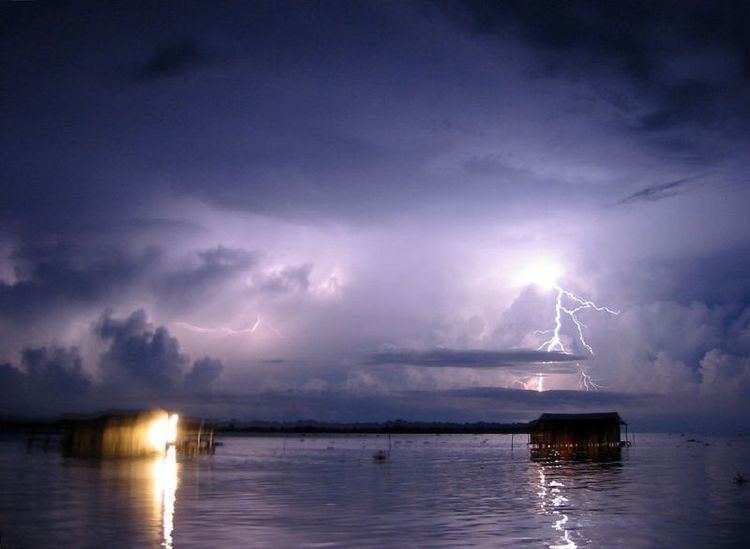 | ||
Catatumbo lightning (Spanish: Relámpago del Catatumbo) is an atmospheric phenomenon in Venezuela. It occurs only over the mouth of the Catatumbo River where it empties into Lake Maracaibo.
Contents
It originates from a mass of storm clouds at a height of more than 1 km, and occurs during 260 nights a year, 10 hours per day and up to 280 times per hour. It occurs over and around Lake Maracaibo, typically over the bog area formed where the Catatumbo River flows into the lake.
Catatumbo lightning changes its frequency along the year, and it is different from year to year. For example, it ceased from January to March 2010, apparently due to drought, temporarily raising fears that it might have been extinguished permanently.
Location and mechanism
Catatumbo lightning usually develops between the coordinates 8°30′N 71°0′W and 9°45′N 73°0′W. The storms (and associated lightning) are likely the result of the winds blowing across the Maracaibo Lake and surrounding swampy plains. These air masses inevitably meet the high mountain ridges of the Andes, the Perijá Mountains (3,750 m), and Mérida's Cordillera, enclosing the plain from three sides. The heat and moisture collected across the plains creates electrical charges and, as the air masses are destabilized by the mountain ridges, result in thunderstorm activity. The phenomenon is characterized by almost continuous lightning, mostly within the clouds, which is produced in a large vertical development of clouds.
The lightning produces a great quantity of ozone though its instability makes it dubious that it has any effect on the ozonosphere.
Previous studies
Among the major modern studies there is the one done by Melchor Centeno, who attributes the origin of the thunderstorms to closed wind circulation in the region. Between 1966 and 1970, Andrew Zavrostky investigated the area three times, with assistance from the University of the Andes. He concluded that the lightning has several epicenters in the marshes of Juan Manuel de Aguas National Park, Claras Aguas Negras, and west Lake Maracaibo. In 1991 he suggested that the phenomenon occurred due to cold and warm air currents meeting around the area. The study also speculated that an isolated cause for the lightning might be the presence of uranium in the bedrock.
Between 1997 and 2000 Nelson Falcón and collaborators conducted four studies, and proposed a microphysics model of Catatumbo lightning. He identified the methane produced by the swamps and the oil deposits in the area as a major cause of the phenomenon. The methane model is based on symmetry properties of the methane. Different studies have indicated that this model does not agree with the observed behaviour of Catatumbo lightning, as - for example - it indicates that there must be more lightning in the dry season (January–February), and less in the wet season (April–May and September–October).
A team from the Center for Scientific Modeling at Universidad del Zulia, coordinated by Ángel G. Muñoz, has investigated the impact of different atmospheric variables on Catatumbo lightning's daily, seasonal and year-to-year variability, finding relationships with the Inter-Tropical Convergence Zone, ENSO, the Caribbean Low-Level Jet, and the local winds and convective available potential energy.
Using satellite data, two groups of researchers led by Rachel Albrecht and Ricardo Bürgesser have provided detailed analysis about Catatumbo lightning's location, timing and number of discharges per square kilometer (density).
Predictability
A more recent study has shown that it is possible to forecast lightning in the Lake Maracaibo basin up to a few months in advance, based in the variability of the Lake Maracaibo Low-Level Jet and its interactions with predictable climate modes like ENSO and the Caribbean Low-Level Jet. The study also shows that the forecast skill is significantly higher when an index based on a combination of winds and convective available potential energy is used. The index seems to capture well the compound effect of multiple climate drivers.
In order to calibrate physical and statistical models to make their forecasts, the team has been acquiring data with tethered balloons and micro-weather stations tied to the balloon's line.
